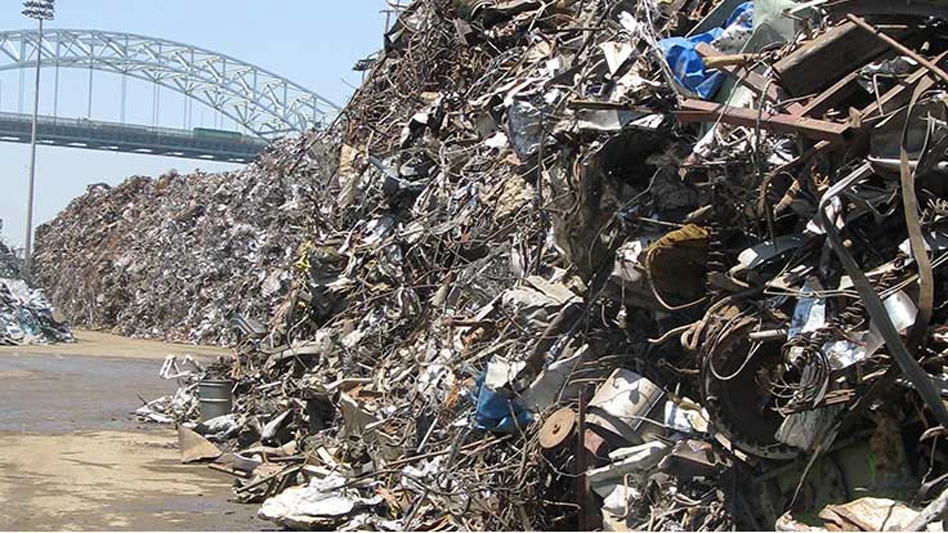
Recycling Today archives
Tension in the ferrous scrap market has continued into March, with severe weather, fluctuating export demand and uncertainty about steel demand in the United States all contributing to a market proving difficult to forecast.
On the supply side, processors Recycling Today contacted characterize inbound scrap flows in the late winter as extremely dependent on the regional weather scenario.
“In the West, flows have been constricted by heavy rain and snow; in some cases, these have been 1,000-year events that dramatically reduced flows,” one processor in that region says.
The reverse of that scenario has been playing out in the Midwest, where a processor says record warmth and lack of snow have increased flows dramatically. In some locations, he says flows are up more than 25 percent.
In MSA Inc.'s Raw Material Data Aggregation Service (RMDAS) pricing covering Jan. 20 to Feb. 19, shredded scrap held its value during that period better than the other most commonly traded grades.
According to RMDAS, U.S. mills paid just $5 per ton less on average for No. 2 shredded in February. Meanwhile, the RMDAS prompt industrial composite grade lost $19 per ton in value, and No. 1 heavy melting steel (HMS) dropped by $11 per ton.
“Shredder feedstock appears to be tight in most regions,” a processor says. “Shredders have been struggling to compete on that grade.”
Reinforcing the regional differences mentioned by a processor, while shredded scrap held its value in the RMDAS North Central/East region, it lost $2 per ton in the North Midwest and dropped by $12 per ton in the South.
No. 1 HMS, a frequently exported grade, suffered its biggest drop in the domestic mill-dependent North Midwest RMDAS region, losing $17 per ton in value in late January and the first two and a half weeks of February.
In the North Central/East and South regions, with greater availability to export docks, No. 1 HMS dropped by $10 per ton in the South and just $9 per ton in the North Central/East.
Heading into the spring, inbound flows and profit margins for processors will depend on price trends that involve both domestic mill demand and overseas interest in U.S.-generated ferrous scrap.
With two months (plus two days) in the books, the Washington-based American Iron and Steel Institute (AISI) calculates steelmakers in the U.S. produced 3.8 percent less steel through March 2 compared with the same time frame in 2023.
Another sign of nervousness could be the AISI steel output figure for the week ending March 2, which was down by 0.6 percent from the prior week. That news came out the same time a construction trade group reported a 0.2 dip in construction spending in the U.S. this January compared with the month before.
As with scrap flows, however, weather could have been an extenuating circumstance in the construction activity drop. “The dip in January is more likely due to bad weather than to weakening demand overall,” says Ken Simonson, chief economist of the Associated General Contractors.
Overseas ferrous scrap buying patterns have been just as touch-and-go as domestic conditions, as judged by reports from Davis Index.
In the first full week of March, a Turkish bidder was able to buy U.S.-origin mixed Nos. 1 and 2 HMS scrap for about $8 metric per ton less than other recent transactions, according to Davis Index.
That news came out the same time as Davis Index reported U.S. mills in early March were, for the third time in three months, asking for steep discounts on their monthly scrap purchases.
Mill buyers started off March asking to pay $70 per ton less for prime grades, some $50 per ton less for shredded scrap and about $40 per ton less for HMS or for plate and structural (P&S) purchases.
Shippers of ferrous scrap likely would portray such prices as a one-time discount, since ratcheting down scale prices would almost certainly lead to a considerable drying up of obsolete grades such as shredded, HMS and P&S heading into April and May.
Exporters on the West Coast—where, as of early March, scrap was hardest to find—could have the closest thing to a counterpoint to offer in late winter and early spring.
A second western U.S. processor tells Recycling Today, “The demand for material off the West Coast has been decent—definitely higher than supply in the region.”
Another potential scrap bright spot for ferrous shippers might be located south of the U.S. border, where Mexican economic indicators are positive in metals-intensive industries such as the automotive sector and other manufacturing categories.
The national statistics bureau in Mexico reports production of light vehicles rose by more than 8.5 percent in the first two months of this year compared with the prior year—or nearly 50,000 vehicles.
Steelmaker Ternium, which operates mills in Mexico, said in late February that “steel demand [has] strengthened in the country, supported by nearshoring activities, manufacturing and infrastructure investment.”
Last year, Luxembourg-based Ternium approved the construction of a 2.6 million ton-per-year electric arc furnace steel slab production facility in Mexico.
Latest from Recycling Today
- BMW Group, Encory launch 'direct recycling’ of batteries
- Loom Carbon, RTI International partner to scale textile recycling technology
- Goodwill Industries of West Michigan, American Glass Mosaics partner to divert glass from landfill
- CARI forms federal advocacy partnership
- Monthly packaging papers shipments down in November
- STEEL Act aims to enhance trade enforcement to prevent dumping of steel in the US
- San Francisco schools introduce compostable lunch trays
- Aduro graduates from Shell GameChanger program





